LAB REPORT
Science and Technology Making Headlines
Dec. 20, 2019


Researchers are working on new sports helmet designs that may help prevent chronic traumatic encephalopathy, the degenerative brain disease linked to repeated hits to the head.
Helmet technology is full steam ahead
Stanford University’s David Camarillo, a nationally respected bioengineer and former college football tight end, and his students are in pursuit of a helmet that will make it safe to play tackle football.
After years of research, only a few scientists believe they can still make such a helmet. Many who study this field say a more sophisticated helmet may even prove dangerous.
Willy Moss, a physicist at Lawrence Livermore National Laboratory, has worked with the Department of Defense, seeking to develop better helmets for players in contact sports and soldiers in war zones. He also has consulted with Camarillo.
He is open to a breakthrough in helmet technology, but he’s not sure it will work to prevent injury.
“You can make whatever changes you want, but in the end it’s all physics,” he said. “Talking of new and better buffers is like Goldilocks and the three foams.”

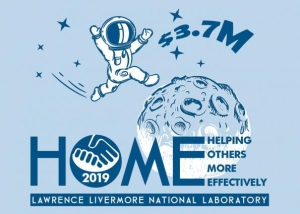
Bringing it HOME
Lawrence Livermore National Laboratory employees, along with Lawrence Livermore National Security (LLNS), LLC, donated more than $3.7 million to charitable organizations via the annual employee giving program, the Helping Others More Effectively (HOME) Campaign.
Through the HOME Campaign, now in its 44th year, Laboratory employees pledged $2,740,935 through payroll deduction, up $15,000 from last year. One hundred percent of the funds donated go directly to agencies that are selected by employees.
LLNS, which manages the Laboratory for the U.S. Department of Energy’s National Nuclear Security Administration, will add $1 million in prorated matching funds to augment employee donations, increasing the contribution value to more than $3.7 million.
Nearly 1,200 employees (15.7 percent) participated this year, benefiting more than 1,200 community/nonprofit agencies in the Tri-Valley, Greater Bay Area, San Joaquin County and beyond.

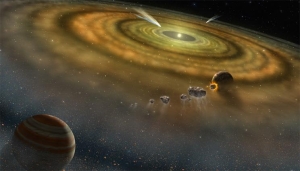
Artist's conception of the dust and gas surrounding a newly formed planetary system. Image courtesy of NASA
Shooting stars link to solar system origins
Meteorites (or what we see as shooting stars) aren’t just a passing phenomenon. Analyzing the elements they’re made of might tell us a lot about how our solar system was formed and evolved from its earliest days.
Scientists from Lawrence Livermore National Laboratory and the University of Münster have reviewed recent work published in Nature Astronomy that shows how the isotopic composition of meteorites and terrestrial planets exhibit a fundamental link to material from the earliest days of the solar system and the processes of planet formation.
The solar system formed 4.5 billion years ago by the gravitational collapse of a molecular cloud core, which resulted in the formation of a circumsolar disk of gas and dust (sometimes called the solar nebula). This disk was ultimately transformed into a planetary system consisting of a single central star, the sun, surrounded by four terrestrial planets in the inner solar system, four giant planets in the outer solar system beyond the "snow line" and a multitude of smaller bodies, including asteroids, moons, dwarf planets and comets.
Although astronomical observations and dynamic modeling provide fundamental insights into the structure and dynamics of protoplanetary disks, and the processes of planetary accretion, the study of meteorites allows the reconstruction of the solar system's earliest history with unprecedented resolution in time and space.

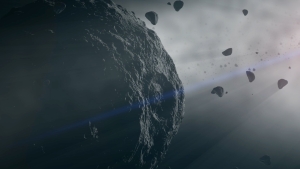
NASA has found that asteroid Bennu is very much active with observable events happening on its surface. Image courtesy of NASA
Ready to rock
Several space experts strongly believe that asteroid Bennu will one day hit Earth and cause massive devastation.
Bennu, a 500-meter wide space rock is an alleged doomsday asteroid that may hit Earth in the 22nd century. In order to explore this space rock, NASA has sent the OSIRIS REx mission, and as per the latest updates, the spacecraft will land on the asteroid to carry samples back to Earth.
Recently, the OSIRIS REx mission found that Bennu is very much active with observable events happening on the space rock's surface. NASA made this conclusion after observing particle plumes ejecting off the surface of Bennu.
In the meantime, Kirsten Howley, a physicist at Lawrence Livermore National Laboratory, had recently suggested that learning the trajectory of asteroid Bennu is very much necessary to combat a possible catastrophe that may happen in the future. Livermore also added that more information regarding Bennu's orbit should be obtained to understand the possibilities of a potential catastrophe.

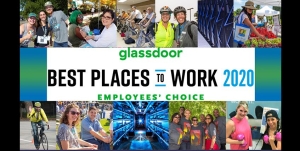
Laboratory is in top form
Lawrence Livermore National Laboratory (LLNL) has been honored for the second year with a Glassdoor Employees’ Choice Award, recognizing the Laboratory as one of the top 10 best places to work nationwide in 2020.
The Employees’ Choice Awards program, now in its 12th year, is based solely on the input of employees who elect to provide feedback on their jobs, work environments and companies on Glassdoor, one of the world’s largest job and recruiting sites.
LLNL, already a 2019 winner, jumped 18 spots for 2020, ranking 6 out of 100 on Glassdoor’s “Best Places to Work -- U.S Large.” LLNL received an overall company rating of 4.5 and is ranked the No. 1 government/government contractor employer and the No. 1 laboratory employer. LLNL also is No. 2 on the list of large employers in the Bay Area.

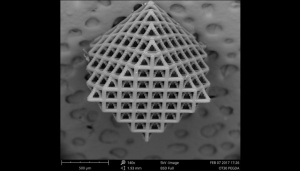
Scanning electron microscopy images of a classic octet lattice built with a projection micro-stereolithography 3D-printing technique.
Making light of heavy loads
Lawrence Livermore National Laboratory (LLNL) researchers have designed a new class of 3D-printed lattice structures that combine lightweight and high stiffness, despite breaking a rule previously thought to be required to exhibit such properties. One of the new structures additionally displays perfectly uniform response to forces in all directions.
As described in a recent research paper, an LLNL team used topology optimization software to create two unique unit cell designs composed of micro-architected trusses, one of which was designed to have isotropic (identical and omnidirectional) material properties. These new structures were then fabricated and tested, and were found to outperform the octet truss, a standard geometric pattern for 3D-printed lattice structures.
To the researchers’ surprise, the trusses appeared to violate the Maxwell criterion, a theory of structural rigidity used in mechanical design that posits that the most efficient load-bearing structures deform only by stretching. In such structures, stiffness scales linearly with density — cutting the structure’s weight in half only reduces its stiffness by half, as opposed to less efficient structures whose stiffness would be reduced by three-quarters or seven-eighths. This linear scaling enables the creation of ultra-lightweight, ultra-stiff mechanical metamaterials.


LLNL Report takes a break
The LLNL Report will take a break for the winter holidays. It will return Jan. 10.





